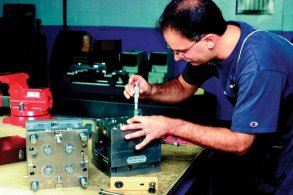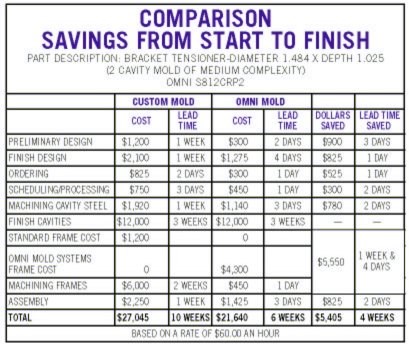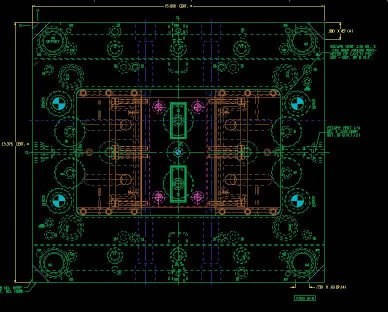Standardized Mold Building Makes Shortened Leadtimes Possible and Profitable
The next level of standardization has allowed moldmakers to rethink their processes and deliver the same high-quality molds, while continuing to succeed and grow.
Today's economy and global competition have left many American moldmakers searching for ways to remain competitive without giving up profits. All of the well-known trade magazines have stories each month about how foreign competition is destroying the manufacturing base in the U.S. At the same time, there are many success stories in the plastics industry about well-run shops that have found ways to remain successful. Most of these stories include a common theme: all of them had to rethink the way they built and designed molds and had done business.
There was a time when most designers felt there was no way of standardizing pockets in mold bases and then designing around the existing geometry. To the contrary, many options in different size ranges have shown that this is quite possible and in fact very flexible. As a result of the intense pressure moldmakers have been faced with in regard to drastically shrinking leadtimes over the last decade, they have had to look for more standardized components to streamline the mold building process. This means using off-the-shelf components. At one time this may have meant lifters, side locks, interlocks, etc., but now, in many instances, it includes the actual mold base as well as the cavity blanks, slide assemblies and pin retainers. These have traditionally been made custom to fit the need at the time of the project. Now, in order to cut out in-house work so time can be spent on the cavity and core details, many shops are turning to off-the-shelf items.
In turn, many molders are starting to embrace this thought process because down the road when things wear out or are broken, they are quickly replaced. They don't need to have extras built with the mold that can drive up costs. These items are mass-produced with tolerances of just a couple ten thousandths of an inch, making them easily replaceable. This means there are no spare parts. Mold designers have had to give up a little control, but have been able to speed design time with no cost to quality.
Shops that have been able to respond, re-think their process and deliver the same high-quality molds, have continued to succeed and grow.
A Revolution Begins
Standardized Mold Building
While leadtimes were diminishing and competition was getting fierce, a revolutionary way of building stand-alone injection molds was taking form. Standardized mold building was the process of planning and designing around a set of mold bases and/or components that had been predesigned and manufactured; machining time was not a part of the equation in the mold building process. Standardized mold building made use of the growing list of off-the-shelf products available to the moldmaker. The ability to order mold components such as complete slide assemblies, round cavity blanks machined with water channels and o-ring grooves, and even mold bases off-the-shelf, and have them in the shop quickly could drastically reduce the amount of work and time for many of the repetitive operations within the moldmaking process. Many moldmakers were hearing, "If you can deliver the tool in six weeks, the job is yours." After quoting a job; they would question, "How are we going to deliver this tool in just six weeks?"
Mold Base Efficiency
It was during this time mold bases that had a majority of the work completed on them were becoming available. Pockets were designed and cut into the plates along with an installed guided ejection. Now, designers were able to start with a CAD file for an existing mold base that was about 90 percent complete. This could greatly reduce design and manufacturing time in the shop. Mold base work that could take forty to fifty hours of shop time, was now taking only about ten to fifteen hours.
"We discovered standardized mold building right at a time when we really needed it," says Patrick Elliott, engineering manager at Prestige Mold, Inc., a custom mold builder in Rancho Cucamonga, CA. "We had a customer demanding a short leadtime while wanting us to maintain the high degree of quality for which Prestige is known." Prestige found a way to use a standardized system, allowing them to finish designing the molding area right away; they did not have to worry about designing the rest of the mold base. Also, by using this concept, they were able to start their cavities and cores sooner and not have to worry about the delivery of the mold base because it was an inventoried item, which would ship to them the day after they ordered it.
According to OMNI Mold Systems (East Hartford, CT)-a mold base and mold component supplier to the plastic injection molding and moldmaking industry-sales manager, Dave LaFleche, "The idea of standardizing a system of mold bases, slide assemblies and cavity sets, that work together, started out of necessity. Our biggest customer needed quick turn-around times to remain competitive. In the beginning, parts were very similar in size and shape, so developing a standard that could be inventoried was fairly easy. As time went on, the candidate parts for quick turns started taking on all different sizes and shapes. We were faced with new needs, and were forced to develop new standards to add to the inventory."
Layout Services
LaFleche says he was able to help Prestige Mold get started with this new mindset. He gave the company a clear picture of the standardized concept, using a free layout service, which helps shops understand how a standardized mold system can work for their project. Moldmakers are able to send a CAD file of their part to the company with critical information such as gating and cavitation. Then, OMNI takes their part geometry and lays it into one of the standardized units that will best fit their application. OMNI then returns a preliminary layout to the company showing the standard components that will complete the design (see Figures 1 and 2). It is not a complete design, but rather a concept of the layout, including the part numbers and prices for all of the products used. OMNI can speed the design process by starting the designer right away with the correct fit. The moldmaker loses no time waiting to find out if his project will fit. There is no hunting through a catalog and no guesswork.
"We were able to take this basic information, and in a day we turned around a preliminary layout showing them the exact standard frame and slide assemblies required for the job. They were able to use our existing files and complete the design based on our standard," says LaFleche. "It was great," says Elliott, "in just one day we had a direction with very little effort on our side. Once we had the preliminary layout we had a platform-a foundation-to work from. We were able to start blocks right away. Because of the standard pocket concept, we knew exactly what sizes we needed before final design even started."
Changing Traditions
Changing the way molds are built is not always easy. Doing away with processes that have been working well for many years often meets resistance. Paul Carney, engineering manager for Batavia, New York-based custom moldmaker and molder, Genesee Precision sees it this way: "We had to change the way we looked at the design process. In the past we designed all of our tools from a custom design thought process," states Carney.
Traditionally, mold designers started with the plastic part to be molded and designed around it. They figured everything based on the part. For example, how big does the pocket have to be so you can fit any water you need around the part for proper cooling? Where will the supports go based on the size of the part and pocket? With a standardized system, an existing pocket is found that will fit the part and the design goes on from there. With a standard mold base, less time is spent on the mold frame because much of the tedious design tasks are already completed. Once a standard design has been found to fit the application, work starts with the molding area.
"Today, by using standardized designs, mold bases and matching components, such as slide assemblies, we are able to speed the design process. The more quickly we get information out to the mold manufacturing floor, the faster our deliveries are," adds Carney (see Figure 3).
This change in the way molds are planned, designed and built, has been helping many American moldmakers to become more competitive in an increasingly global market. Along with the increased dependence on high-speed machining (HSM) and even robotics in mold building, standardized mold bases and components allow mold manufacturers to spend much needed time on cavity and core details, ensuring a high degree of quality still goes into each and every tool. "Our moldmakers are not spending time hogging out pockets and installing guided ejection, supports or any of the other tedious activities associated with the mold. We are now afforded the luxury of having our moldmakers focused on the more intricate and profitable cavity and core details," Carney says.
Advantages
An added advantage to using mold bases and/or components that have been previously designed, built and inventoried, is that it allows for an increased number of molds to be built with the same manpower. In today's competitive atmosphere, jobs are sometimes won or lost based on leadtimes. Leadtimes are directly tied to a company's ability to manage manpower. Standard mold designs limit much of the up-front planning, as well as reduce assembly times. Factor in the saved machining times and the ability to have the moldmaker focus on molding detail, and managing manpower becomes much more focused and efficient.
The ability to quote shorter leadtimes through standardized mold building is helping some companies to win more work. "Ironically, this product was produced partly to reduce the amount of work that needs to be done by the moldmaker, but at the same time it is increasing the amount of work he gets," states LaFleche.
Today, with shorter leadtimes faced by moldmakers and intense competition from both foreign and domestic competitors, everyone agrees that changes are needed. Moldmakers can no longer enjoy the security of a full pipeline. Gone are the days of having eighteen or twenty weeks of work in the tube. Instead, moldmakers need to be ready to respond and deliver in six weeks or less. Only by searching out new answers that will allow a quick and efficient response to fill customers needs, will moldmakers survive in today's moldmaking industry. Change never comes easily, but then neither does success.
Related Content
6 Ways to Optimize High-Feed Milling
High-feed milling can significantly outweigh potential reliability challenges. Consider these six strategies in order to make high-feed milling successful for your business.
Read MoreThe Ins and Outs of Hot Runner Temperature Control
A training checklist that explains the why and how of proper hot runner temperature control and system management.
Read MoreMoldmakers Deserve a Total Production Solution
Stability, spindle speed and software are essential consideration for your moldmaking machine tool.
Read MoreLaser Welding Versus Micro Welding
The latest battle in finely detailed restoration/repair of mold materials.
Read MoreRead Next
How to Use Continuing Education to Remain Competitive in Moldmaking
Continued training helps moldmakers make tooling decisions and properly use the latest cutting tool to efficiently machine high-quality molds.
Read MoreReasons to Use Fiber Lasers for Mold Cleaning
Fiber lasers offer a simplicity, speed, control and portability, minimizing mold cleaning risks.
Read More











.jpg;maxWidth=300;quality=90)











